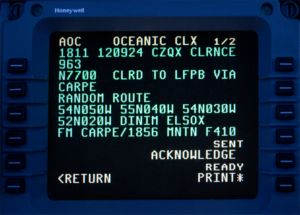ICAO have released a Concept of Operations paper discussing the plan for the removal of Oceanic Clearances in the North Atlantic Region. Here’s what it says…
The “Executive Summary” bit
There have been big improvements in safety and monitoring capabilities in the NAT region. Things like ADS-C, CPDLC, ADS-B, NATS and NAVCANADA using a common Flight Data Processor Platform (something to do with aligned procedures) etc have really improved everything.
Because of all this, the big wigs in the POG (real acronym – stands for NAT Procedures and Operations Group) have started to think about discontinuing the Oceanic Clearance in NAT airspace.
How does it work at the moment?
Right now, to enter NAT controlled airspace at or above FL60, you need an oceanic clearance. This clearance contains your Route, Level and Speed.
These three elements are important because they are what enables the management of the lateral, vertical and longitudinal separation.
So, when you are zooming along towards your Oceanic Entry Point, and despite having a flight plan filed, you still need to actually be cleared – meaning ATC have to confirm (and then you sort of reconfirm back at them) what Route, Level and Speed you’ll be flying through the region at.
So you send your RCL (Request for Clearance) to the ATC who manages the first OCA you’ll be entering and they send you the clearance.
Simple, until stuff goes wrong.
Why change it?
Like we said, it’s all straightforward, until it isn’t.
Each OCA has its own published “when to send the RCL” rules. There often isn’t a huge amount of time between receiving a clearance and reaching the OEP, and during this time you have to check the clearance, possibly reprogram bits, and from experience on long haul flights, it always seems to happen around the time the augmenting crew are returning from the bunks. So the risk of errors creeps up.

You can enter the NAT region without a clearance but…
Then you have things like Radio Comms failures, loss of HF etc. and all the “what to do if” procedures related to what to do if you do have clearance, don’t have clearance, are in the region or aren’t in the region…
The general rule is if you’re already in the NAT HLA then stick with your clearance. If you aren’t in yet but have a clearance then enter and stick with it, and if you don’t have a clearance then follow what is in your flight plan.
But all this does cause confusion. Can I enter? Should I not enter? Where do I send the RCL to? When do I send it? What if I haven’t heard back?
So removing the need to request a clearance prior to entry would align the NAT region with normal global procedures and would mean less training and simplified procedures for crew, and everyone like simple.
It isn’t actually an entirely new concept either – New York Oceanic removed oceanic clearances some time ago and it was a fairly simply procedural change for ATC and flight crew, so it does work.
So what will change?
Simply put – Oceanic Clearances to operate in oceanic airspace will no longer be issued to flight crew prior to reaching the OEP. Instead, crew would send an RCL and would get back some common message along the lines of:
“RCL RECEIVED. FLY CURRENT FLIGHT PLAN OR AS AMENDED BY ATC”
Any changes will be sent via CPDLC or advised by voice comms.
Will it work?
Well, making stuff more simple usually means less mess-ups.

Example clearance.
In this case crew will have their clearances already – they will know what to fly and potentially have more time to check and crosscheck.
When changes do occur it will be clearer that there is a re-clearance and this could minimise the risk of missing a change to the clearance, or mis-entering it and flying the wrong thing.
Procedures for what to do if you cannot make contact prior to entry will also, hopefully, be simplified, so the stress of “what if I don’t hear from ATC before the OEP” will be reduced.
But when is it going to happen?
Well, that’s the less exciting bit. If they decide that it is something worthy of implementation then it will probably only go ahead by 2030.
Details of planned implementation dates will be published in common NAT Ops Bulletins and in State AICs/AIPs so keep a look out.
Can I read the CONOPS paper?
Yes you can. It is right here.
Not sure about the current clearance process?
We wrote a little brief on it a while back which you can read here.
More on the topic:
- More: Back to the Radio: Gander Goes Voice-Only Pre-Oceanic
- More: NAT Crossing after GPS spoofing: a guide
- More: NAT Ops: Atlantic Thunder 22
- More: NAT Basics: An Unofficial Checklist For Pilots
- More: No more NAT tracks at FL330 and below
More reading:
- Latest: Venezuela & Caribbean Airspace Update
- Latest: ReFuelEU: Europe’s new anti-tankering rules explained
- Latest: Milan targets business jets with 650% rate increase
- Safe Airspace: Risk Database
- Weekly Ops Bulletin: Subscribe
- Membership plans: Why join OPSGROUP?











 Get the famous weekly
Get the famous weekly 






Thanks Rebecca for reporting.
How does this connect with the planned/(intended?) removal of the NAT-tracks?
Kind regards,
tom
Last I heard, the NIL NAT Tracks “thing” was just a trial and they have not said anything about continuing that now traffic levels are increasing. This removal of clearances is separate, but we will keep an eye out for more updates on the NIL tracks trials and hopefully it is something that they continue considering.
Rebecca…please contact me concerning your article on removal of the oceanic clearance…Rich Stark 678-793-6190